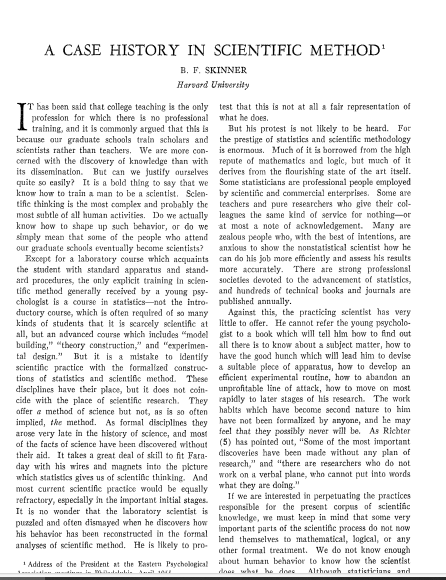
This excerpt from B.F. Skinner’s 1956 paper, “A Case History in Scientific Method,” recounts his personal research journey, highlighting the contrast between formalized scientific methodology and his own experimental practices. Skinner emphasizes the importance of direct observation of behavior, rejecting the rigid application of statistical methods and theoretical models. He advocates for a focus on individual cases and the manipulation of experimental variables to achieve control, rather than relying on large sample sizes and statistical significance testing. His narrative showcases a more flexible and opportunistic approach to research, emphasizing serendipity and adaptation in response to unexpected results. The paper ultimately promotes a shift towards a more practical and less theoretically driven approach to the study of behavior.

Insights from B.F. Skinner’s “A Case History in Scientific Method”
1. What is the main point Skinner is trying to make about how scientific research is actually conducted versus how it’s often portrayed?
Skinner argues that the formalized procedures of statistics and scientific methodology, while useful, do not accurately represent the messy, often unplanned, and serendipitous nature of real scientific discovery. He emphasizes that many important discoveries arise from practical engagement with a phenomenon, rather than from a strictly pre-planned hypothesis-testing framework. He is suggesting that these formal methods came after a lot of actual science was done, not before, and that perhaps we should acknowledge the importance of these less formalized methods of scientific investigation, even if we do not yet understand how they work.
2. How does Skinner’s personal experience with rats illustrate his point about the real process of scientific discovery?
Skinner recounts how his research on rats evolved organically, driven by unexpected observations, practical needs, and chance encounters. He describes starting with a device to study adaptation to novel stimuli, moving to postural reflexes in baby rats, then using a platform to study the force of a rat’s movement, and eventually creating self-reinforcing devices and cumulative recorders. This journey was characterized by abandoning established plans, re-purposing existing apparatus, and finding unexpected order in seemingly irrelevant observations, like the rat’s delay before starting another run. This demonstrates how observation and serendipity can be more instrumental to discovery than rigid adherence to a predefined methodology.
3. What are some of the “unformalized principles of scientific practice” that Skinner identifies, and how do they contrast with traditional scientific method?
Skinner highlights several “unformalized principles” that guide his research:
- When you run into something interesting, drop everything else and study it.
- Some ways of doing research are easier than others.
- Some people are lucky.
These contrast with the conventional emphasis on pre-defined research questions, strict experimental design, and statistical validation. Skinner’s approach prioritizes adapting to the data and following where it leads, rather than rigidly adhering to a pre-set plan. He argues these are skills scientists develop from actual work, not from textbook instruction.
4. Why does Skinner express skepticism about the value of large sample sizes and statistical methods in behavioral research, and what does he propose as an alternative?
Skinner cautions that while large sample sizes and statistical methods are useful, their importance can be overstated, especially in the context of studying individual behavior. He points out that averaging data from large groups may mask the individual variability that is crucial for understanding the underlying processes of behavior. Instead, he advocates for a focus on refining experimental variables and manipulating environmental conditions to eliminate variability. By doing this, researchers can then directly observe orderly processes in the behavior of a single organism, which is a more informative approach for his purposes than relying on averaged data from groups.
5. What is the significance of the cumulative recorder in Skinner’s research and why does he consider it an important scientific tool?
The cumulative recorder allowed for a visual representation of the rate of responding over time. Instead of just seeing pips on a graph, the cumulative recorder displayed a line, where the slope of the line indicated the rate. This simple change in the method of recording led to the discovery of very fine-grained details about changes in the rate of responding over time. Skinner considers this an important tool that, like a microscope or telescope, makes aspects of behavior visible that would otherwise be missed. The cumulative curve enabled him to identify orderly changes in behavior that might be obscured by more conventional methods.
6. How does Skinner’s shift to a technology of behavior (specifically in the context of animal training) influence his approach to scientific research?
The shift to animal training forced Skinner to focus on achieving very specific and reliable behavioral outcomes. This practical orientation led him to emphasize the direct manipulation of environmental variables. He needed a methodology that would be effective for actually getting animals to do things, which led him to emphasize environmental manipulations rather than theories of learning, highlighting the value of a technology of behavior, which contrasts with a theory of behavior. This experience further reinforced his conviction that behavior could be shaped and maintained by controlling contingencies of reinforcement, and that this can be done on an individual basis. This, in turn, influenced his belief that psychologists should focus on experimental manipulations to generate useful and repeatable results rather than large sample studies or statistical averaging.
7. What does Skinner mean when he says that “the organism whose behavior is most extensively modified and most completely controlled in research… is the experimenter himself”?
This statement emphasizes that the process of scientific research is itself a form of behavioral conditioning. The experimenter is constantly being reinforced by the results of their work, whether those results are predicted or not. When the experimenter finds something they are interested in, they change their own behavior to focus on that, similar to the way a rat is conditioned in an experiment. This perspective suggests that scientific progress is not a purely objective and rational process but is shaped by the interactions between the researcher and the subject matter, reinforcing his point that the scientific method itself is emergent and subject to change.
8. How does Skinner’s case history relate to the broader issue of how we should train scientists, and what is his main recommendation regarding scientific practice?
Skinner suggests that traditional graduate education, with its emphasis on statistics and formal methods, fails to capture the skills needed for true scientific discovery. He advocates for an approach that encourages direct engagement with subject matter, flexibility in adapting research strategies, and the pursuit of unexpected observations. His main recommendation is that we should focus on training scientists to be astute observers and experimenters by doing science, rather than fitting their practices into an externally imposed framework. He argues that by embracing the dynamic and sometimes messy process of scientific exploration, we can better foster true scientific progress.
A Case History in Scientific Method: Study Guide
Short Answer Quiz
- According to Skinner, what is the primary focus of graduate schools, and why might this be a problem in training scientists?
- How does Skinner distinguish between the formalized constructions of statistics and scientific method versus actual scientific practice?
- What does Skinner mean when he says some of the “most important discoveries have been made without any plan of research?”
- Briefly describe Skinner’s initial experiment with rats in a “Parthenon” structure and what he discovered in this process.
- What was the major change in Skinner’s recording method that resulted from using a spindle and string to record data?
- What event led to Skinner’s discovery of extinction curves?
- What did Skinner learn from the work of a graduate student who ran an experiment with a cat on a Sunday?
- What is serendipity, and how does it relate to Skinner’s research process?
- How does Skinner use the example of training dogs to blow up tanks to challenge traditional theories of learning?
- How does Skinner argue that a focus on individual behavior can circumvent the need for some statistical analyses?
Answer Key
- Graduate schools, according to Skinner, are primarily concerned with the discovery of knowledge rather than its dissemination, which may lead to insufficient training in the actual practice of scientific thinking. They often train scholars but not necessarily scientists.
- Skinner argues that statistics and formalized scientific method offer a method of science, but not the method, because they arose late in scientific history and do not capture the initial stages of scientific research. They often reconstruct scientific practice but do not describe it.
- Skinner notes that research isn’t always conducted as planned, some of the most important discoveries come from the process of exploration and happenstance, rather than being the result of carefully planned experiments. He argues that not all researchers are aware of or able to articulate their processes.
- Skinner began with a rat in a soundproofed box with a “Parthenon”-like structure. He discovered young rats who had babies and abandoned the initial experiment, pivoting to a study of postural reflexes in young rats.
- Skinner’s use of a spindle and string to record data shifted his recording method from simply reporting the up and down movement of the runway to producing a curve that revealed the rate and changes in rate of responding, which would have been otherwise missed.
- Skinner discovered extinction curves when his food magazine jammed which caused him to treat this as a defect until eventually, he deliberately disconnected the magazine, and observed the resulting extinction curve.
- Skinner learned from the story of the graduate student who ran the cat without reinforcement that, when an animal is not rewarded after performing the behavior they learn, it will cease to perform it. This experience led him to explore the effects of intermittent reinforcement.
- Serendipity is the art of finding one thing while looking for something else. It relates to Skinner’s process as many discoveries occurred while he was seeking other things, such as his discovery of fixed-ratio reinforcement while seeking a way to control rat deprivation.
- Skinner uses the example of training dogs to challenge traditional theories by highlighting how behavioral technology, focused on manipulation of environmental conditions, can shape and maintain behavior without relying on principles and hypotheses. He used this experience to show how training was a function of direct observation and analysis, rather than theoretical frameworks.
- Skinner argues that through the refinement of experimental variables and focusing on the individual case, one can reduce variability and observe behavioral processes directly, eliminating the need for statistical analyses that often obscure individual patterns.
Essay Questions
- Discuss Skinner’s critique of traditional scientific methodology and the role of statistics in psychology. How does he propose an alternative approach to scientific inquiry?
- Analyze the significance of Skinner’s “case history” of his own research. What does his personal experience reveal about the nature of scientific discovery and the scientific process?
- Explore the evolution of Skinner’s experimental apparatus, from the “Parthenon” structure to the cumulative recorder. What do these changes suggest about his evolving understanding of behavior and his scientific methods?
- Examine the implications of Skinner’s work on shaping behavior for both experimental and practical contexts. How does the concept of “controlling human behavior” through environmental manipulation impact traditional ideas of individual agency?
- Compare and contrast the use of group data with single-subject analysis, according to Skinner. What are the advantages and disadvantages of each, and what conclusions does he draw about their relative value in the study of behavior?
Glossary of Key Terms
- Behaviorism: A school of psychology that focuses on observable behaviors rather than internal mental states.
- Conditioned Reflex: A learned response to a stimulus that was previously neutral, associated with the work of Ivan Pavlov.
- Cumulative Curve: A graph that records the total number of responses over time, often used to study patterns of behavior.
- Extinction Curve: A graph that shows a decline in a learned behavior when reinforcement is no longer provided.
- Fixed-Interval Reinforcement: A schedule of reinforcement where the first response after a set interval is reinforced
- Fixed-Ratio Reinforcement: A schedule of reinforcement where a specific number of responses must occur before reinforcement is given.
- Functional Analysis: An approach that studies the purpose or function of behavior by analyzing its relationship to environmental factors.
- Hypothetico-deductive method: A scientific approach that formulates a hypothesis and designs an experiment to determine if it’s true or not.
- Kymograph: An instrument used to record physiological movements, which was adapted by Skinner to record behavioral responses.
- Operational Analysis: Defining concepts based on the procedures used to measure them, rather than on assumed mental states.
- Reinforcement: A process that strengthens the likelihood of a behavior occurring again.
- Serendipity: Finding one thing while looking for something else, or “happy accidents,” relevant to the scientific process.
- Shaping: A process of reinforcing successive approximations of a desired behavior.
- Statistics: A mathematical discipline for collecting and analyzing numerical data.
- Technological Application: Using scientific methods to solve real-world issues and make useful devices.






















0 responses on "A Case History in Scientific Method"